My Visit to Angkor Wat and Siem Reap – Cambodia
Cambodia’s Angkor Wat is considered one of the man-made wonders of the world. It’s the largest Hindu temple complex in the world. In 1992 it was designated a UNESCO World Heritage Site. It’s also one of three major ancient temples in SE Asia. The other two are Borobudur in Java, Indonesia and Bagan in Myanmar.
Of all the places I visited in Cambodia, Angkor Wat and nearby Siem Reap town were easily the most enjoyable and impressive. While I did not particularly like the rest of Cambodia, I absolutely loved the Angkor Wat region. I personally always tell travelers visiting Cambodia to make a bee-line to Siem Reap and visit the astounding Angkor Wat region for a few days. Here’s what I discovered during my week-long visit:
Brief history of Angkor Wat:
The temples of Angkor were built by the Khmer kingdom (pronounced “come ere”) which flourished in the region between roughly 800-1400 AD. Cambodians are descendents of the Khmers and refer to themselves and their language as Khmer.
Eventually, the old kingdom fell into decline and the entire temple complex was forgotten (How could that happen?) and ‘eaten’ by the jungle. The temples were ‘discovered’ again in the mid 1800s by Frenchman Henri Mouhot. In the early 1900s French expeditions began reclaiming the temples from the jungle and renovating them. More extensive renovations continue to this day.
Angkor Wat today:
Angkor Wat (wat = temple) is a somewhat confusing name as it refers to both Angkor Wat, the region’s most famous temple, and the vast area containing hundreds of temples spread through a huge forest.
Angkor Wat is the largest and best preserved temple. It was the sole temple not forgotten or eaten by jungle, as it continued being used by Buddhist monks after the Khmer Empire disappeared. So, truth be told, when the French ‘discovered’ Angkor Wat it was already well-known by local monks.
Angkor Wat (the temple) is an indisputably impressive sight with it’s giant surrounding moat, five majestic towers and dozens of stone walls intricately carved with floral designs, dancing nymphs and massive battle scenes.
My visit to Angkor Wat:
It took me several hours to explore just that one temple. I’m sure any sculptor/geology/temple aficionado could easily spend a whole day, or an entire week, examining all the carvings, towers and architectural details.
In addition to Angkor Wat’s grandeur, what made Angkor Wat (the region) particularly impressive to me was the amazing forest. Giant trees with massive trunks send thick sprawling branches and dense foliage up into the sky, way overhead. The few roads passing through the area are lined and shaded by those magnificent towering trees.
Although the region is technically a jungle, to me it felt more like a deciduous forest. The graceful giants give Angkor a serene, peaceful atmosphere. Huge leaves drift down from the sky, birds chirp eagerly and cicadas add their loud buzzing drone.
Scattered around that serene forest of giants are several other temples, walls and former ‘temple cities’. Each temple has its point of fame. One is being engulfed by giant trees. One has 54 stone towers of huge carved faces. One is massive but crumbled. One consists of five large stone bathing pools.
Many old ‘temple city’ walls still stand, protecting their interiors. Narrow stone gates lead inside. Once I stepped inside though, I was always surprised to find myself simply standing amidst more forest. It was mind-boggling to try imagining that those vast walled spaces full of trees used to be cities.
Inside those walled forests I also stumbled upon scattered temples in various states of ruin or repair. Some had mostly crumbled into piles of rubble. Some were slowly being crushed, hugged and swallowed by giant trees.
The walls themselves and their intricate carvings were also in various states of decay, the work of rain, wind, lichens, mosses and trees. In many places I could faintly make out formerly-elaborate carvings, though they were much softened by weather and jungle. Occasionally I stumbled upon a very well-preserved section of carvings and discovered that they were even more elaborate than I’d guessed.
I couldn’t help but think that the Angkor region would be heaven for anyone interested in the process of natural deterioration. Scientists could excitedly examine all the varieties of lichens, the process of stone flaking and crumbling and softening, how trees manage to move stone.
Exploring Angkor Wat by bicycle:
I spent three glorious days exploring the Angkor Wat complex by bicycle. Each morning I excitedly pedaled 10 km (6 miles) from my guest house in nearby Siam Riep town. I intently visited temples, walls, carvings and statues for two days. The third day I spent blissfully cycling amidst the wonderful giant trees and relaxing in the supremely serene forest.
On my final evening I enjoyed a spectacular sunset from Angkor’s most famous mountaintop temple, which affords sweeping views over Angkor Wat, the grand forest and a distant lake.
Siem Reap:
Meanwhile, I spent my evenings in charming Siem Reap. Truth be told, it’s the only town I liked in Cambodia. Siem Reap is full of lovely old French colonial architecture. The town sits along a small river, which is lined by parkland and more giant trees. There’s also a separate city park full of more giants. The compact town has a large local market, which makes it easy to find cheap food.
A few big international hotels are located in Siem Reap. They offer traditional Khmer dance/dinner buffet shows. I didn’t want to join an expensive buffet dinner, so asked one hotel receptist about just having a cocktail or dessert instead. “Sure, that’s no problem”! So for the price of a Singapore Sling I got to sit in their outdoor garden and watch traditional Khmer dance and have a cocktail.
All in all, visiting Siem Reap and Angkor Wat was a wonderful experience which I highly recommend to any and all travelers to SE Asia.
QUESTIONS:
Have you visited Angkor Wat yet?
If so, what did you like best?
If not, would you like to go?
——————————————————————————————————————————–
You might also enjoy:
———————————————————————————————————————————–







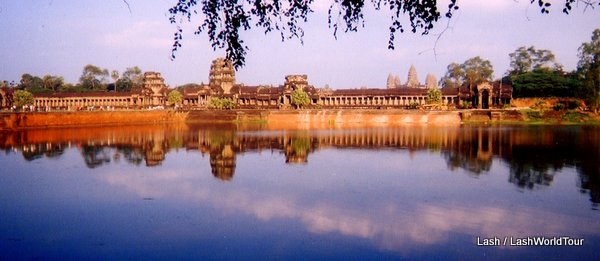
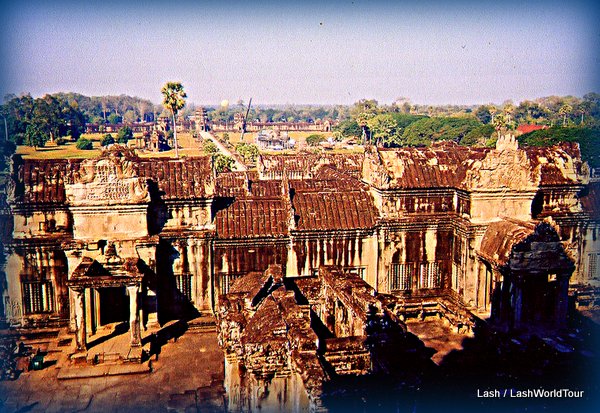
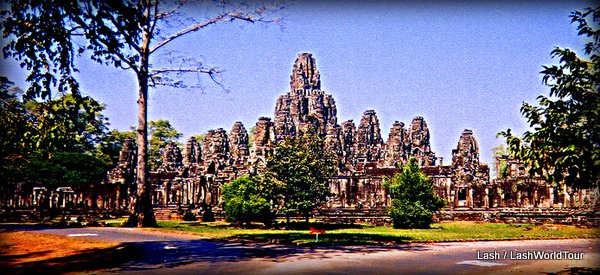
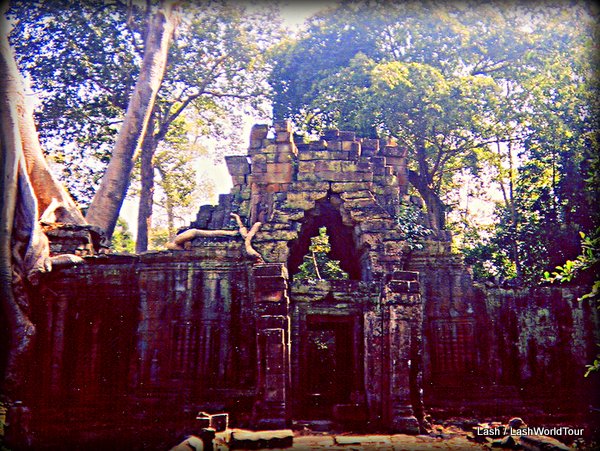
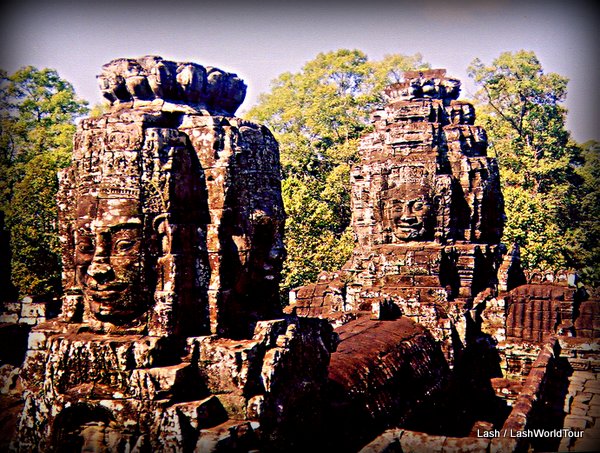
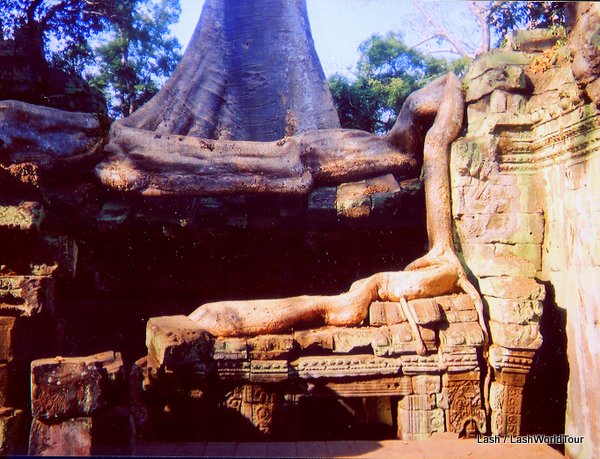
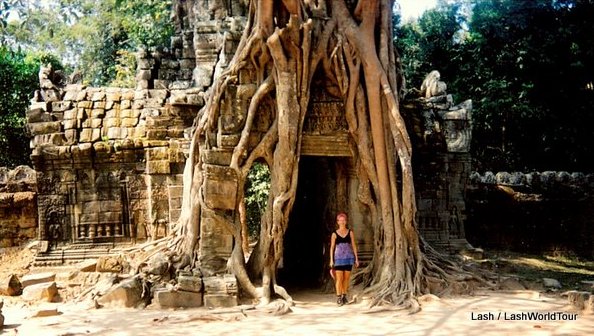
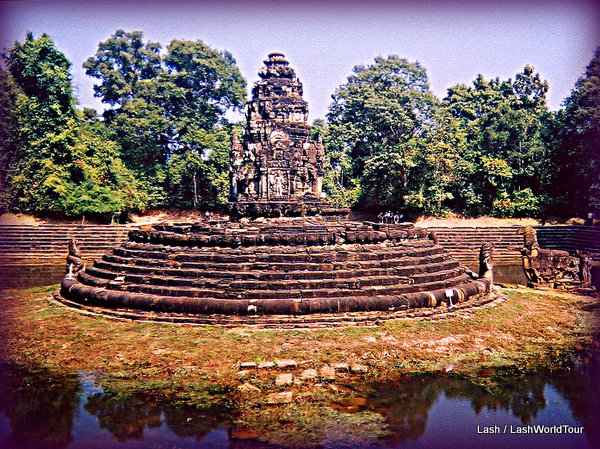
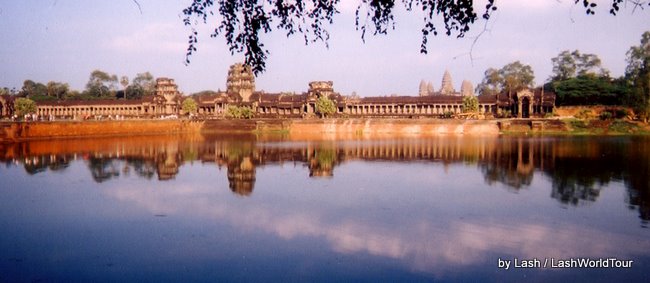
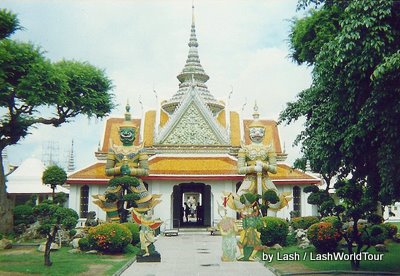
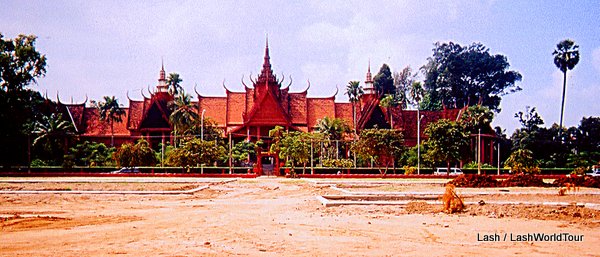

 Hi! I'm Lash, an American nomadic world traveler who's been traveling solo since 1998. I’m passionate about traveling the world nomadically and then sharing it all with you. I hope to inspire you to travel the world, to entertain you with tales from the road, and to help you reach your travel dreams. Welcome!
Hi! I'm Lash, an American nomadic world traveler who's been traveling solo since 1998. I’m passionate about traveling the world nomadically and then sharing it all with you. I hope to inspire you to travel the world, to entertain you with tales from the road, and to help you reach your travel dreams. Welcome! 




10 pings
Skip to comment form ↓
My Impressions of Phnom Penh Cambodia - LashWorldTour » LashWorldTour
2013/01/23 at 8:13 pm (UTC 8) Link to this comment
[…] LashWorldTourTravel Blog offering Cultural Insights, Travel Tips, and Tales of Adventure from 14+ years of world travelsHOMEABOUTAbout LashWorldTourAbout LashContactWhat’s in a name?LashWorldTour Travel MapLash’s Travel Fast FactsMissionsWorld Travels Overview: 1991-2011PressDisclaimerCOUNTRIESASIABALI- INDONESIABalinese CultureDiving in BaliBicycling in BaliAmedSanurBali MiscBANGLADESHBRUNEICAMBODIASHANGHAI- CHINAHONG KONGINDONESIABaliJavaLombokJAPANLAOSMALAYSIAKuala LumpurPenangLangkawiBorneoDiving in MalaysiaMalaysia MiscMYANMARNEPALPHILIPPINESSINGAPORESRI LANKATHAILANDVIETNAMAUSTRALIAEUROPEENGLANDSPAINS AMERICABRAZILUSAAdventuresBicycle TravelCycling in Bali SeriesHikingMotorbike TravelScuba DivingSky DivingSurvivor TV CrewTravel DisastersWWOOFCruisesTravel TalesCulturePhoto GalleriesTravel Tips10 Free Things to do in… SeriesAccommodation TipsFlight TipsLuxury Travel TipsMoney TipsSafety TipsWhy Living Overseas is Better SeriesMisc Travel TipsBeyond GuidebooksTravel ResourcesTRAVEL INTERVIEWSBook ReviewsHotel – Tour – Museum ReviewsLINKSTravel StoreFREE eBookTravel Books StoreLash’s Guidebooks to Bali wp_flash_img_show will display here (config: default)« PHOTO GALLERY: El Chorro and El Torcal National Parks – Spain My Impressions of Phnom Penh Cambodia 2013/01/23 by Lash WorldTourNational Museum in Phnom Penh – CambodiaMy Impressions of Phnom Penh CambodiaLeaving Vietnam to reach Cambodia entailed yet another day-long bus ride, this time from Saigon to Cambodia’s capital, Phnom Penh: three hours to the border, an hour for everyone to pass through Vietnamese and Cambodian immigration points, a break for lunch and another four hours to central Phnom Penh.I got my first impressions of Cambodia at the border and it was certainly different from Vietnam! The border itself consisted of an attractive red-stone gate set in a 100-yard-wide strip of heaped up dirt, messy fields and heaps of rubble. Not a good sign… The road beyond was rough dirt. Gone were Vietnam’s paved roads.border gate to CambodiaAt least there was one sign of progress- the road was being extensively reconstructed, though it looked like it might take a few years to complete with the scraggly construction crew on site. Needless to say, I endured a rough, bumpy four-hour ride to Phnom Penh.Another immediate difference were the people. While the Vietnamese looked Chinese to me, the Cambodians looked Thai/SEAsian. The Cambodians had darker brown skin and wider, flatter faces.Their manners were entirely different too. Just by crossing a border I was suddenly freed from being continually pointed at, poked, touched and grabbed. Whew! Cambodians are definitely not touchy, feel-y, pokey, grabby! They are much less aggressive and calmer. I liked that, a lot.Cambodian children – CambodiaUnfortunately, I soon was subjected to people continually laughing at me instead. That pissed me off just as much as the Vietnamese habits of poking and prodding. I quickly found myself day-dreaming of an escape to Thailand, where the locals continually smile and tell me how beautiful my fuschia-colored hair is.In any event, our bus eventually arrived in Phnom Penh’s guesthouse area, lakeside, at dusk. The rooms in Cambodia were another major change from travel in Vietnam. For nearly the same price as rather luxurious budget rooms in Vietnam, I suddenly found myself ‘treated’ to bare-bones rooms with tilted sinks (if any), cheap linoleum flooring, paper-thin walls and dodgy construction. Goodbye luxury budget travel!backpackers’ lakeside area – Phnom Penh – CambodiaOn the other hand, Phnom Penh’s guesthouses all had large wood verandas set out over a small lake full of thick floating foliage. We guests were spared roads, traffic and noisy boats. The atmosphere was quite pleasant and peaceful.Unfortunately, the immediate area was basically a slum of jumbled up dirt alleys, dark at night, with garbage and mess strewn about and packed with local residents’ tiny shacks. Yucko! At least in Vietnam people live in reasonable, if small, houses and the roads are paved and comparatively clean.Cambodia was decidedly less developed than Vietnam.As for Phnom Penh, I can sum it up easily in one word: blaaaaaaaaaahhhhh! It’s a surprisingly huge city of nondescript sprawl leading for many miles in every direction. There’s not an interesting building or shop in sight.typical neighborhod street – Phnom Penh – CambodiaAnother good word for the city is: pigpen. A few main roads were smoothly paved, but all the side streets were rumbled, potholed dirt roads heaped up with garbage piles and lined by dull little shops. Kids were running all over the place all day long, apparently not attending school. Many beggars filled the city, mostly children, women with babies, old nuns and crippled or amputee-d men.In fairness, I will admit Phnom Penh has one very nice area. Located along the wide Mekong River are the Royal Palace (where the current King and Queen actually reside), the Royal Silver Palace and the beautiful National Museum. A wide park lines the river, although the river banks are cemented and garbage is strewn all about.Statue at a round-about in Phnom Phen, one of the few attractive buildings in townThroughout the city, several extremely wide boulevards are lined with big fluffy trees. In fact, most streets in Phnom Penh are lined with trees, lending a softer edge. There are no tall buildings, so the city has a rather relaxed, town-like feeling, betraying its vast unending, impoverished sprawl.Aside from the palace/river area, though, there’s not much besides blaaahh and slum. In fact, I saw all of Phnom Penh’s ‘attractions’ in just two short days of cycling and exploring. That included visits to the gorgeous Royal Palace/Silver Temple and the National Museum, which is full of stone and bronze statues of Buddha and various Hindu gods. Bangkok, in contrast, would require at least a week to visit its main temples, shopping areas and other sites.beautiful Silver Pagoda – Phnom PenhSo after my two short days of sightseeing, I plunged into Phnom Penh’s reputedly great nightlife. ‘Heart of Darkness’, the most popular club did have an amazing ‘World-Asian’ decor and atmosphere, but… well, the music sucked. They actually played Michael Jackson’s ‘Thriller’ –some 20 years after its debut! And that was one of the better songs. All I could say is, “Help!”I quickly discovered that the city’s other bars and nightclubs suffered from an overdose of hip-hop. It was definitely not my scene. It was ok as a novelty for a change of pace (for about an hour). But after one night of clubbing it was time for me to move on from Phnom Penh.Given my impressions of the city, I was astounded to meet several westerners who liked it. Eh? Like what? I didn’t get it. A surprisingly large number of westerners were living there, most of them involved in aid/help/ development/volunteer work. Apparently that’s the appeal of Phnom Penh for those so inclined. It is admirable and Cambodia certainly does need help after its atrocious devastation by Pol Pot and the Khymer Rouge.Well, those charitable westerners were welcome to Phnom Penh as far as I was concerned.I myself ‘escaped’ the blasé city on a bus to Cambodia’s coastal beach area of Sihanoukville.Read about that trip in my next story coming soon…(* FLickr CC photo credits: azwegers / McKaySavage / struple / Cambodia4kidsorg *)——————————————————————————————————————–Meanwhile, you might also like:My Visit to Cambodia OverviewMy Visit to Angkor Wat and Siem Reap——————————————————————————————————————— /* /* Leave a Reply Cancel replyYour email address will not be published.Name:Email:Website:Message:You may use these HTML tags and attributes: <a href="" title=""> <abbr title=""> <acronym title=""> <b> <blockquote cite=""> <cite> <code> <del datetime=""> <em> <i> <q cite=""> <strike> <strong> […]
Sihanoukville Cambodia » LashWorldTour
2013/11/26 at 2:03 pm (UTC 8) Link to this comment
[…] En route I stopped at famous Angkor Wat / Siem Reap. Thankfully, that proved to be the one great place I visited in Cambodia. Read about my visit to Angkor Wat here […]